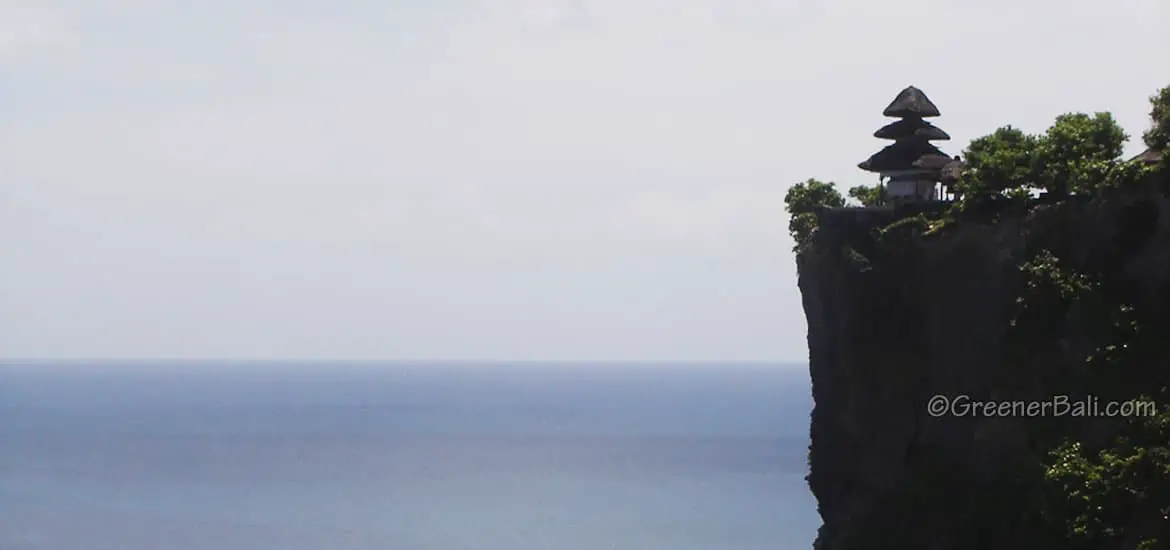The stunning Ulu Watu temple or Pura Luhur Uluwatu as the locals call it, is located right on an edge of a cliff on the southern tip of the Badung Peninsula. This sea temple is one of the five temples dedicated to the gods who guard the sea.
The other four Hindu sea temples, Tanah Lot, Pura Sekenan, Pura Rambut Siwi and Pura Petitenget are all found along the south coast as well.
We think that the temple of Ulu Watu is not as impressive as other Balinese temples. However the cliffs dropping 100 metres into the clear Indian Ocean create a dramatic and amazing setting on the edge of the Bukit Peninsula.
Uluwatu Temple, a must to see…Because of its remote location not that people come to visit the temple. If you are able to find time to drive there, you should. You’ll be surprised what you are going to find.
Visiting Ulu Watu Temple
Everybody who visits this place of worship must wear a sarong and a temple scarf. These can be obtained when paying the entrance fee. This is also considered as a small donation to the temple.
Before arriving at the actual Uluwatu temple you have to walk a couple of metres past colonies of macaque monkeys. Some say that they can be really aggressive. We experienced the opposite as the monkeys hardly showed any interest. It was probably the heat. Noon is not the most comfortable time to go…
Climbing up the stairsWe thought that the drive from Jalan Legian in Kuta Beach to Jalan Raya Uluwatu would be really quick. Unfortunately our planning didn’t really work out and before we realised it the sun was burning straight on our heads. The sea breeze was not even able to cool us off. So try to visit the temple in the morning or late afternoon…
And beware you have to climb 71 stairs before you reach the temple.
The history behind Ulu Watu Temple
The temple was built in the 16th century by Danghyang Nirartha, a Javanese Hindu priest. He fled to Bali after the Majapahit kingdom collapsed in Java due to the influence of the Islam. It is said that Nirartha achieved enlightenment at Ulu Watu.
But the story does not stop here…
A Balinese legend describes how the gods of the Majapahit kingdom followed their people when they fled from Java to Bali. The ship of Dewi Danu, the goddess of water, finally arrived at Uluwatu.
Once she touched the shore, a cliff rose hundred meters up on which the temple now stands. The pointy cliff reflects the bow of her ship.
The cliff from the left angleAs mentioned before the name of the temple is Pura Luhur Ulu Watu, ‘Ulu’ means ‘head’; ‘Watu’ means ‘rock’ and ‘Luhur’ is a combined description of the words ‘heavenly, ancestral, original and inspiring’.
The temple is made from coral and therefore the temple must have been sparkling white once. But due to centuries of erosion it has now its current dark colour. The meru with the 3 roofs standing on the edge of the cliff is dedicated to Shiva, the Destroyer.
About a century ago only the Prince of Badung was allowed to enter the temple however he was killed by the Dutch during the ‘puputan’ in 1906. It is still maintained by the royal Denpasar family but is owned by the Balinese people who come to pray here.
Especially Balinese fishers come here who worship Dewi Laut, the Sea Goddess.
What to see?
You can walk around the whole temple complex except for the ‘jeroan’, the inner most courtyard. This area is off-limits to non-worshippers but can be viewed from the side. On both sides of the temple there are paths along the ridge of the cliff.
If you take the path to the right and walk past the ‘bale’ you will finally end up at the edge of another cliff. From where you can take amazing pictures of the temple, the cliffs and the Indian Ocean.
On the left side of the temple there is an open-air theatre. Every night at 6 pm you can witness a kecak and fire dance performance at sunset making the temple even more astonishing.

